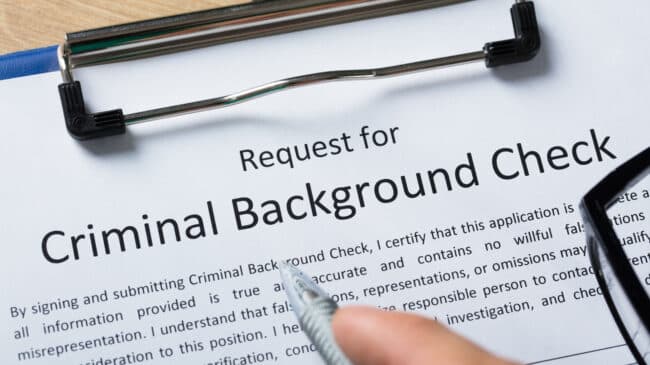When a person is convicted of a crime, the judge imposes a punishment that is supposed to hold the person accountable for the precise acts on which the conviction rested.
When the sentence is over, however, there is a cascade of perpetual impacts—which function as additional punishment—that occurs as a result of most convictions. These impacts are not imposed by the judge, and they are not individually tailored to address the specific conditions of the crime the person committed. These perpetual punishments include debilitating and cumulative impacts on a person’s ability to secure housing, jobs, and education and to fully participate in many aspects of civic life.
The official name for these extra punishments is “collateral consequences,” though they are hardly collateral, and they are littered throughout our state and federal codebooks. Some have referred to these additional consequences as “invisible punishments.”
At the federal level, some overbroad examples are a law that retracts certain loans for anyone who is convicted of a drug trafficking offense, another that makes them ineligible for government benefits, and nobody with any drug conviction can get federal student loans. Many states, such as Illinois, take away state contracts or cause termination from certain jobs for anyone with any drug conviction. In Florida, you are ineligible to serve as a personal representative in a person’s estate if you have been convicted of any felony. There are consequences for parents (even as simple as not being able to volunteer at your child’s school).
According to the Brennan Center for Justice, “roughly 600,000 people leave prisons every year” and are subject to the flood of consequences that crop up after their sentences have ended. It feels to these individuals, rightly, that they are never free again and that they are set up for failure.
The extent of these perpetual punishments had only ballooned since the 1970s, when there were already almost 2,000 statutes limiting the professional licensing of people with convictions. Today, just in the licensing arena, there are more than 27,000 licensing limitations on record. And these are not just for felonies—more than 6,000 of those apply to misdemeanor convictions. What’s more, many of these are permanent, and more than 11,000 are mandatory. And to add insult to injury, other than some immigration consequences that courts have required a defendant to be apprised of before a plea or trial, the American Bar Association Criminal Justice section notes in its Collateral Consequences of Criminal Convictions Judicial Bench Book, “defendants are generally not entitled, as a matter of due process, to be warned of these consequences, either before accepting a plea or upon conviction.”
The formidable barriers to success are reflected in the rates at which people are accused of new crimes—three-year average state recidivism rates are around 68 percent. Barred from most housing and jobs, returning to crime may often seem like the only option.
What can be done to give people a fair chance to succeed after completing the court-imposed punishment? It would make sense if these “collateral” consequences were considered to be additional punishment, but unfortunately, courts have almost uniformly held that collateral consequences are not punishment. Many advocates and scholars think the courts have gotten this wrong.
With the courts punting, the gold standard would be for the judge to build into the actual sentence the length of any period during which the conviction would remain on the person’s record—so the sentence would include a date certain for expungement. In practice, an expungement removes the record and relieves all collateral consequences. But expungements are few and far between. Meanwhile, many sealing provisions merely remove the conviction from public databases so that a person can more easily obtain employment and housing. Ideally, sentencing guidelines or laws would set parameters for how long certain crimes are able to be open on an offender’s record and/or criteria for judges to consider when setting that part of the sentence.
Another promising approach, so far adopted by 12 states, is to automatically wipe a conviction from a person’s record (expungement) some reasonable period after the crime if they have not committed any new crimes, or at least to seal the record so it is not visible to non-law-enforcement officials. Unfortunately, however, “most states limit record clearing to less serious convictions, with lengthy waiting periods and complex procedural requirements that discourage record relief even for those who are eligible,” according to the Collateral Consequences Resource Center (CCRC). Among the states that have passed automatic record-clearing laws, a plethora of implementation issues have arisen in state after state, ranging from data quality to difficulties calculating waiting periods.
By contrast with the U.S. system, many European countries successfully provide for automatic or close-to-automatic expungements. The U.S. should follow the examples set by these countries.
While automatic expungements after the expiration of a judge’s determination of the appropriate time or after a set amount of time set by statute are the best policies, other measures are also valuable. They could be widely adopted to offer relief to those who have served their sentences. One option is to allow judges or departments of corrections officials to provide certificates of relief, which are not expungements but improve a person’s ability to succeed before being eligible for expungement or sealing. These certificates, offered by different states under various names, serve to remove various mandatory bars imposed as a result of the conviction or, in some cases, supply a court order declaring the subject to be rehabilitated. The National Conference of State Legislatures explains that these certificates—which go by different names in different jurisdictions—can help people overcome the obstacles to employment, housing, and other needs, as well as offering “some reassurances to employers or landlords about the person’s rehabilitation and employability.”
The chief difference between these kinds of certificates is that they do not conceal or erase the conviction from public view. Different states allow the certificates to be issued by different authorities—courts, parole boards, corrections agencies, or other entities. The aim is to restore rights forfeited upon conviction, but the effect depends on the circumstances: the specific rights restored depend on a multitude of factors, including the state, the offenses of conviction, and the time elapsed since the sentence was completed. Some states restore rights to be considered for employment or housing; in North Carolina, occupational licensing boards are instructed to weigh a certificate favorably in their consideration of the candidate. So far, only about two dozen states offer any of these types of options.
CCRC and some partners established a national inventory of collateral consequences in 2017, and the Uniform Law Commission has proposed a model bill that would require judges to consider and individually tailor the application of consequences for each defendant and allow “certificates of rehabilitation” to be provided by the department of correction a reasonable period after conviction.
There are other ways to reduce some of these invisible punishments. Pardons eliminate the structural barriers to reentry and could play a bigger role. That said, executive clemency has been vastly underused, with only 17 states even having a regular process that results in a significant number of grants.
Judges can play a much greater role in ensuring defendants are aware of the consequences they will suffer in addition to the ones included in their sentences. Judges can also take the initiative to craft the sentence, from the beginning to the end, by building in the restoration of civic privileges at a certain time, such as the end of a custodial sentence or after a period of supervision in the community.
Defense counsel can (and more frequently does, especially since there has been an accessible resource to discern applicable sanctions) negotiate with prosecutors for charges that don’t carry as many penalties.
Keeping people with a criminal record (which is one in three adults) from fully reintegrating into community life is dangerous and unsound. It puts people who have made mistakes in the past in a permanent state of civil exclusion and limits our neighbors from pursuing legal employment and gaining stability. Justice and economic success demand that we set a course to abandon the wide application of additional impacts on people who have completed their court-imposed sentences.

